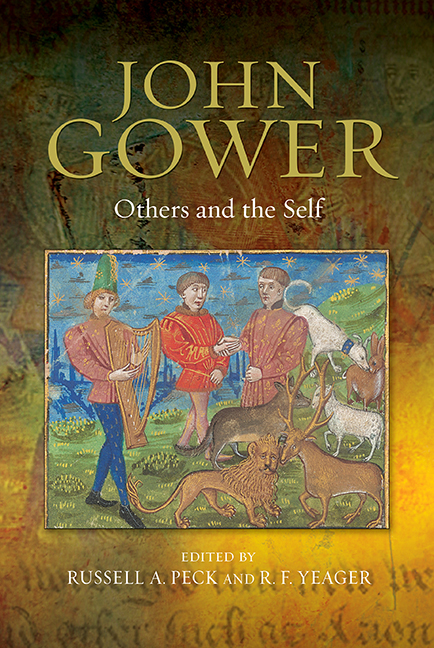Book contents
- Frontmatter
- Contents
- List of Illustrations
- Abbreviations
- Introduction
- PART I KNOWING THE SELF AND OTHERS
- 1 The Materiality of Cognition in Reading, Staging, and Regulation of Brain and Heart Activities in Gower's Confessio Amantis
- 2 The Sound of My Voice: Aurality and Credible Faith in the Vox Clamantis
- 3 “Noght withoute peine”: Chastity, Complaint, and Lucrece's Vox Clamantis
- 4 Reading Faces in Gower and Chaucer
- 5 Gower and Mortality: The Ends of Storytelling
- PART II THE ESSENCE OF STRANGERS
- PART III SOCIAL ETHICS, ETHICAL POETICS
- Bibliography
- Index
- VOLUMES ALREADY PUBLISHED
1 - The Materiality of Cognition in Reading, Staging, and Regulation of Brain and Heart Activities in Gower's Confessio Amantis
from PART I - KNOWING THE SELF AND OTHERS
Published online by Cambridge University Press: 30 April 2019
- Frontmatter
- Contents
- List of Illustrations
- Abbreviations
- Introduction
- PART I KNOWING THE SELF AND OTHERS
- 1 The Materiality of Cognition in Reading, Staging, and Regulation of Brain and Heart Activities in Gower's Confessio Amantis
- 2 The Sound of My Voice: Aurality and Credible Faith in the Vox Clamantis
- 3 “Noght withoute peine”: Chastity, Complaint, and Lucrece's Vox Clamantis
- 4 Reading Faces in Gower and Chaucer
- 5 Gower and Mortality: The Ends of Storytelling
- PART II THE ESSENCE OF STRANGERS
- PART III SOCIAL ETHICS, ETHICAL POETICS
- Bibliography
- Index
- VOLUMES ALREADY PUBLISHED
Summary
Medieval writers, even the philosophers, delighted in playing with the twists and turns of cognition. The very foundation of empirical thought rested upon speculation through suppositional logic and the relativities of perspectivist theory. Philosophers—from Robert Grosseteste, Roger Bacon, and Duns Scotus to William of Ockham, Thomas Bradwardine, Robert Holcot, and Chaucer's “philosophical” Strode––experimented with the logic of possibilities. Cognition is a thought-process, a dialectica with a plotable narrative, what Hugh of St. Victor refers to in the Didascalicon as narrationis processus (a narrative drama), a series saeculi (a cognitive sequence within a grammatical time frame). All the philosophers share the same brain model that originated with Galen. And so do Gower, Chaucer, Langland, and Lydgate, who commonly refer directly or indirectly to Galen and his three-ventricular theory of the brain, with its capacity to speculate on meaning within the pathways of supposition as it attempts to construct meaning out of experience. The abstraction of ideas from the senses in conjunction with memory and desire leads to what the philosophers refer to as the “multiplication of species.” This mental interplay of possibilities sets the stage for fictive literature of the sort especially dear to Gower. The brain is the writer's staging arena. As we will see in the second part of this essay, the same is true for his characters, who voice and act out their choices within the diegesis of their own minds.
Medieval Conceptions of the Brain and Cognition
Medieval brain diagrams, based on Galen, depict an interplay between intuitive and abstractive cognition. In preparation for discussion of cognition and the brain's staging of evidence in the Confessio Amantis, I have assembled a primer on cognition based upon medical diagrams of the brain and human body found in medieval and early Renaissance medical texts or philosophical arguments. Ultimately, the drawings derive from Galen (or Aristotle through Galen), as conveyed by Arabic translations and adaptations of Alhazan, Averroes, and Avicenna, and modified further by subsequent Latin translators. Such drawings, along with their commentaries, are second nature to Gower and his audience. They demonstrate how vision, hearing, and one's experience of the outside world pass through the senses, especially the eye and ear (CA I.iv.289–302), into one's thought-processing intellect, there by illustrating the operative formulations of cognition.
Information
- Type
- Chapter
- Information
- John Gower: Others and the Self , pp. 7 - 31Publisher: Boydell & BrewerPrint publication year: 2017
